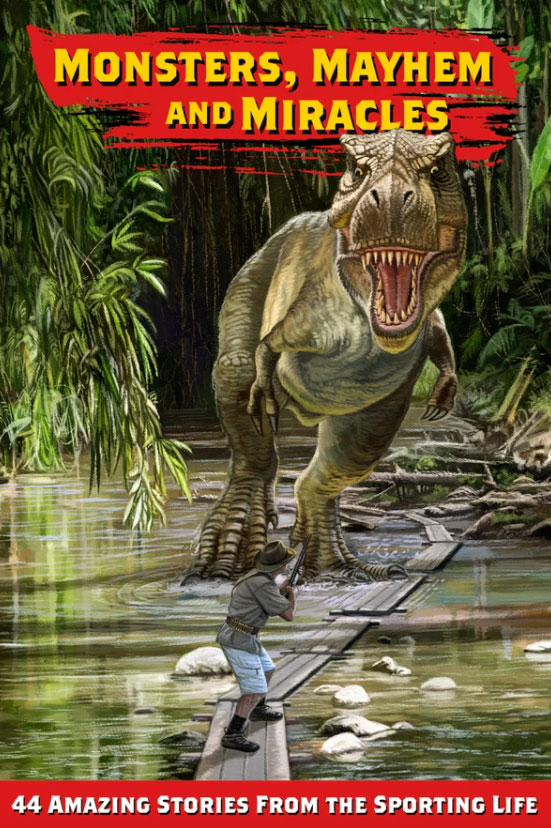Our Editorial Director, Scott E. Mayer, called me into his office to help him mount and bore-sight a scope on a Mossberg Patriot Predator 308 Win. After a few instructions on the rifle itself and its constituent parts, he handed me an envelope and a blank “Thank You” card. He proceeded by saying, “now, be sure to write a thank you letter — for this is your rifle.”
Scott had recently returned from a rather successful hunt in Kansas. Partnered with a few names most of our readers would recognize was Linda Powell from Mossberg. Apparently, they had discussed my recent onboarding and some of my writing. The rifle gifted to me was the same utilized in the successful hunt.
“Sorry,” Scott said, “I used it first on that deer I bagged.”
“No worries,” I responded. Still at a loss for words – yes, that even happens to writers – I just nodded my head, focusing in on the moment.
Just a few days prior to this surprise gifting, I had sparked a conversation – or somewhat autistically piled-on a lengthy elucidation – via an email back and forth with Jim Casada regarding my goals here at Sporting Classics. I found that correspondence to be thematically linked, or akin to this act of unanticipated charity. I spoke of my aim to bring engaging content to Sporting Classics, but with a renewed appreciation for accuracy – a concept that I operate under the presupposition is a form of love.
 Accuracy is a tacit default cognitive orientation in the West (and I believe in reality as a whole). It’s an ancient conceit. Goes back to the beginnings of philosophy in Greek culture (a culture that, while having stern critiques of, I hold a deep appreciation for). Aristotle spoke of accuracy when employing the motif of archery in his writings. And even Homer himself understood this concept intuitively, for one of his most famous characters, Odysseus, was, among many other rather duplicitous things (for instance, a soothsayer), a keen archer. When Odysseus returns home to Ithaca in disguise after 20 years away at war, including his long journey back, to find men occupying the halls of his home, drinking his wine, eating his food, trying to seduce his wife and take his kingdom, what does he do to demonstrate to Penelope, his wife, that he is who he says he is? He strings a bow and plucks an arrow through hoops. Revealing himself to be true, as accurate as possible.
Accuracy is a tacit default cognitive orientation in the West (and I believe in reality as a whole). It’s an ancient conceit. Goes back to the beginnings of philosophy in Greek culture (a culture that, while having stern critiques of, I hold a deep appreciation for). Aristotle spoke of accuracy when employing the motif of archery in his writings. And even Homer himself understood this concept intuitively, for one of his most famous characters, Odysseus, was, among many other rather duplicitous things (for instance, a soothsayer), a keen archer. When Odysseus returns home to Ithaca in disguise after 20 years away at war, including his long journey back, to find men occupying the halls of his home, drinking his wine, eating his food, trying to seduce his wife and take his kingdom, what does he do to demonstrate to Penelope, his wife, that he is who he says he is? He strings a bow and plucks an arrow through hoops. Revealing himself to be true, as accurate as possible.
The Greeks have a term, hamaratia. Although in the dramatic/literary sense, this word is understood as the tragic and fatal flaw – “moral flaw” – leading to the downfall of a hero/heroine, it literally means “to miss the mark”, “to err;” however, it also means “to sin.” In the most fundamental sense, at the root of Western philosophy (and more pointedly, the Christian faith, the good news which St. John broadcast to the world through the Greek language – for he wrote his gospel using their lexicon), inaccuracy is synonymous with evil. Evil, in its essence, is a distortion of what is True. Four out of the Ten Commandments, the first three and the ninth, are explicitly about not distorting the Truth of God. Hence why Satan is considered the great seducer and cunning liar. He functions on inaccuracy. From false aesthetics to logical fallacies. The angel Satan/Lucifer was the most powerful creature ever created, belonging to and overseeing, the Seraphim which were the highest-ranking angels. Lucifer/Satan became intoxicated with all his power, drunk enough on it that he saw himself as the creator of his greatness; he was of the delusion that he was God. And the moment he convinced himself of this, he and a third of the angels fell with him from Grace and Good. The fall from Good was produced by the prideful and delusional inaccuracy of Lucifer/Satan. Accuracy is Good, a form of Love. It’s no coincidence that Cupid is an archer.
 As Odysseus was sailing home, one of the many challenges that befell him was to get by Scylla and Charybdis. The answer to this predicament? Accuracy: aim through the middle of the two unpleasant alternatives – Circe tells Odysseus to sail “closer” to Scylla than Charybdis, but he still goes between the two, his aim is accurate, therefore he survives. This is a True insight into reality that, prior to Christ, the Hellenics simply didn’t grok explicitly. This is because they didn’t have the example set yet — Christ had yet to Incarnate Himself into history. The example to aim for was set in every act of Christ while He was here in human history; these acts redeemed not just the “damned if you do, damned if you don’t” worldview of the Hellenics, but mankind, human nature and nature itself. When Christ was crucified, it was done so between two thieves (in this context Scylla and Charybdis <but you can name any two evils, Communism/Fascism, Tyranny/Anarchy, Veganism/Vegetarianism…>) and the “way” is through the middle. And, apropos of the season, when Christ was born, three wisemen followed a star, accurately assessing the correct trajectory, to greet him and Mother Mary.
As Odysseus was sailing home, one of the many challenges that befell him was to get by Scylla and Charybdis. The answer to this predicament? Accuracy: aim through the middle of the two unpleasant alternatives – Circe tells Odysseus to sail “closer” to Scylla than Charybdis, but he still goes between the two, his aim is accurate, therefore he survives. This is a True insight into reality that, prior to Christ, the Hellenics simply didn’t grok explicitly. This is because they didn’t have the example set yet — Christ had yet to Incarnate Himself into history. The example to aim for was set in every act of Christ while He was here in human history; these acts redeemed not just the “damned if you do, damned if you don’t” worldview of the Hellenics, but mankind, human nature and nature itself. When Christ was crucified, it was done so between two thieves (in this context Scylla and Charybdis <but you can name any two evils, Communism/Fascism, Tyranny/Anarchy, Veganism/Vegetarianism…>) and the “way” is through the middle. And, apropos of the season, when Christ was born, three wisemen followed a star, accurately assessing the correct trajectory, to greet him and Mother Mary.
 For world history, the ancient Greeks were a fascinating and impressive culture. It is no wonder their civilization is known to historians as “the Greek miracle;” however, they were fundamentally wrong in their thinking. The Greeks, too, fell victim to delusional inaccuracies; they were a prideful people who valued intellect and self foremost. They thought in dialectics, or the belief that the universe was composed of “oppositions.” Whereas Christ showed us that nothing is in “opposition,” but, rather, all things – including evil – are subservient to one Good. It is in this sense that the Greeks ultimately missed the mark. They, and so many other traditions before and since, see Good and Evil as two co-equal forces ever battling it out for the win. But that is inaccurate. For Good, the Good of God, through Christ, in the Holy Spirit, is omniscient, omnipresent and omnipotent. Evil, because God granted freewill, and holds true to that commitment, is tolerated and thus serves the Good — much to the chagrin of its originator, Satan/Lucifer. All Satan’s efforts to distort the Good, outmaneuver Good, didn’t, doesn’t and won’t succeed. Providence will prevail because the Good is the fundamental principle in the Person of The Father, who created all of reality by working through the Son, in the Holy Spirit. The aim all along, before the fall, was that through Christ’s Incarnation, from the Father, in the Holy Spirit, would the imperfect creature He created, man, be redeemed and be brought in to higher ranking than all of the angels. This is why Satan hates mankind and labors in inaccuracies, distractions and misperceptions to damn him; he aims to deviate man from the goal of salvation and everlasting life; he labors to make you commit the sin of missing the mark, keeping you from the love of your True Home. The Good prevails in the end. That Good is the True aim we should all keep in our sights, particularly this Yuletide season.
For world history, the ancient Greeks were a fascinating and impressive culture. It is no wonder their civilization is known to historians as “the Greek miracle;” however, they were fundamentally wrong in their thinking. The Greeks, too, fell victim to delusional inaccuracies; they were a prideful people who valued intellect and self foremost. They thought in dialectics, or the belief that the universe was composed of “oppositions.” Whereas Christ showed us that nothing is in “opposition,” but, rather, all things – including evil – are subservient to one Good. It is in this sense that the Greeks ultimately missed the mark. They, and so many other traditions before and since, see Good and Evil as two co-equal forces ever battling it out for the win. But that is inaccurate. For Good, the Good of God, through Christ, in the Holy Spirit, is omniscient, omnipresent and omnipotent. Evil, because God granted freewill, and holds true to that commitment, is tolerated and thus serves the Good — much to the chagrin of its originator, Satan/Lucifer. All Satan’s efforts to distort the Good, outmaneuver Good, didn’t, doesn’t and won’t succeed. Providence will prevail because the Good is the fundamental principle in the Person of The Father, who created all of reality by working through the Son, in the Holy Spirit. The aim all along, before the fall, was that through Christ’s Incarnation, from the Father, in the Holy Spirit, would the imperfect creature He created, man, be redeemed and be brought in to higher ranking than all of the angels. This is why Satan hates mankind and labors in inaccuracies, distractions and misperceptions to damn him; he aims to deviate man from the goal of salvation and everlasting life; he labors to make you commit the sin of missing the mark, keeping you from the love of your True Home. The Good prevails in the end. That Good is the True aim we should all keep in our sights, particularly this Yuletide season.
Thank you, Linda, for your generosity, hitting the heart of someone many miles away.
Thank you, Scott, for focusing your thoughtfulness on my growth by orienting Linda’s magnanimity in my direction.
Your aims were true.
Thank you, Sporting Classics readers, for your kind attention and time spent honing-in on the stories we aim to bring to you; it is in the spirit of this reciprocal, gifted giving we wish to continue for another 40 years and beyond.
I aim, also, to keep you all posted on this rifle’s many Christmases to come.
 Truly a first in the world of outdoor publishing, Monsters, Mayhem and Miracles is a one-of-a-kind collection of unforgettable tales from the sporting world. Its 44 stories range from harrowing encounters with deadly predators to astonishing tales involving spirits, ghosts and even the devil himself.
Truly a first in the world of outdoor publishing, Monsters, Mayhem and Miracles is a one-of-a-kind collection of unforgettable tales from the sporting world. Its 44 stories range from harrowing encounters with deadly predators to astonishing tales involving spirits, ghosts and even the devil himself.
Featuring both fictional and true-to-life adventures, these astonishing stories are from the creative minds of such legendary authors as Peter Capstick, Archibald Rutledge, Gene Hill, Mike Gaddis, Roger Pinckney and John Madson.
On these 354 pages, you’ll also find hilarious predicaments, stunning feats of bravery and dramatic rescues as hunters and anglers are caught up in deadly encounters with everything from bears, moose and man-eating lions to sharks and crocodiles. Altogether, you’ll not find a more endearing and absorbing collection of wild and wacky stories. Buy Now




